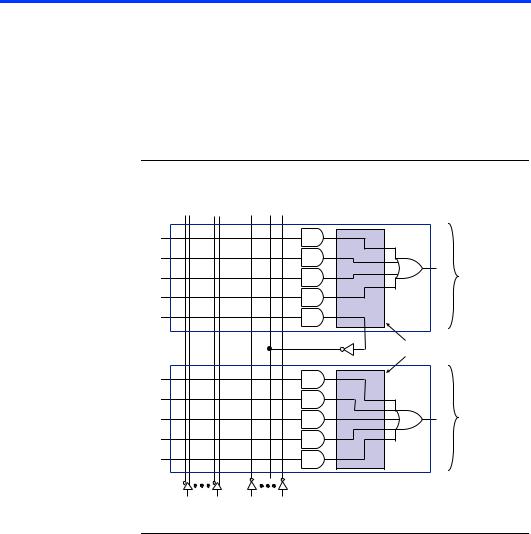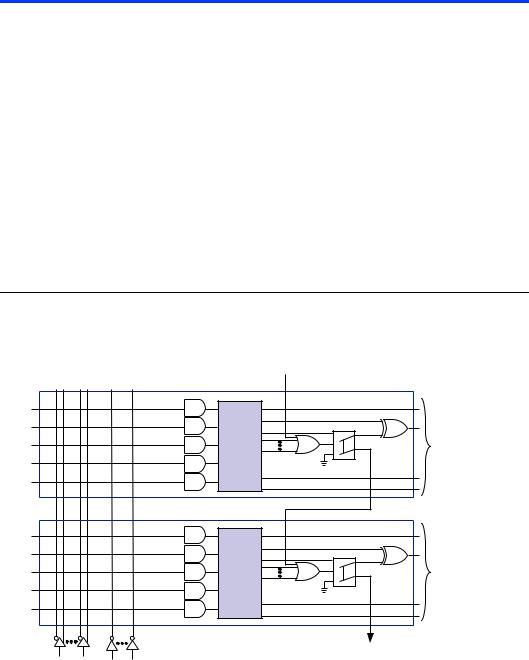
- •Features...
- •Logic Array Blocks
- •Macrocells
- •Expander Product Terms
- •Shareable Expanders
- •Parallel Expanders
- •Programmable Interconnect Array
- •I/O Control Blocks
- •In-System Programmability (ISP)
- •Programming Sequence
- •Programming Times
- •Programming a Single MAX 7000S Device
- •MultiVolt I/O Interface
- •Open-Drain Output Option (MAX 7000S Devices Only)
- •Slew-Rate Control
- •Programming with External Hardware
- •IEEE Std. 1149.1 (JTAG) Boundary-Scan Support
- •Design Security
- •Generic Testing
- •Timing Model
- •Version 6.7
- •Version 6.6
- •Version 6.5
- •Version 6.4
- •Version 6.3

MAX 7000 Programmable Logic Device Family Data Sheet
Each programmable register can be clocked in three different modes:
■By a global clock signal. This mode achieves the fastest clock-to- output performance.
■By a global clock signal and enabled by an active-high clock enable. This mode provides an enable on each flipflop while still achieving the fast clock-to-output performance of the global clock.
■By an array clock implemented with a product term. In this mode, the flipflop can be clocked by signals from buried macrocells or I/O pins.
In EPM7032, EPM7064, and EPM7096 devices, the global clock signal is available from a dedicated clock pin, GCLK1, as shown in Figure 1. In MAX 7000E and MAX 7000S devices, two global clock signals are available. As shown in Figure 2, these global clock signals can be the true or the complement of either of the global clock pins, GCLK1 or
GCLK2.
Each register also supports asynchronous preset and clear functions. As shown in Figures 3 and 4, the product-term select matrix allocates product terms to control these operations. Although the product-term-driven preset and clear of the register are active high, active-low control can be obtained by inverting the signal within the logic array. In addition, each register clear function can be individually driven by the active-low dedicated global clear pin (GCLRn). Upon power-up, each register in the device will be set to a low state.
All MAX 7000E and MAX 7000S I/O pins have a fast input path to a macrocell register. This dedicated path allows a signal to bypass the PIA and combinatorial logic and be driven to an input D flipflop with an extremely fast (2.5 ns) input setup time.
Expander Product Terms
Although most logic functions can be implemented with the five product terms available in each macrocell, the more complex logic functions require additional product terms. Another macrocell can be used to supply the required logic resources; however, the MAX 7000 architecture also allows both shareable and parallel expander product terms (“expanders”) that provide additional product terms directly to any macrocell in the same LAB. These expanders help ensure that logic is synthesized with the fewest possible logic resources to obtain the fastest possible speed.
Altera Corporation |
11 |

MAX 7000 Programmable Logic Device Family Data Sheet
Shareable Expanders
Each LAB has 16 shareable expanders that can be viewed as a pool of uncommitted single product terms (one from each macrocell) with inverted outputs that feed back into the logic array. Each shareable expander can be used and shared by any or all macrocells in the LAB to build complex logic functions. A small delay (tSEXP) is incurred when shareable expanders are used. Figure 5 shows how shareable expanders can feed multiple macrocells.
Figure 5. Shareable Expanders
Shareable expanders can be shared by any or all macrocells in an LAB.
|
Macrocell |
|
Product-Term |
|
Logic |
|
Product-Term Select Matrix |
|
Macrocell |
|
Product-Term |
|
Logic |
36 Signals |
16 Shared |
from PIA |
Expanders |
Parallel Expanders
Parallel expanders are unused product terms that can be allocated to a neighboring macrocell to implement fast, complex logic functions. Parallel expanders allow up to 20 product terms to directly feed the macrocell OR logic, with five product terms provided by the macrocell and 15 parallel expanders provided by neighboring macrocells in the LAB.
12 |
Altera Corporation |

MAX 7000 Programmable Logic Device Family Data Sheet
The compiler can allocate up to three sets of up to five parallel expanders automatically to the macrocells that require additional product terms. Each set of five parallel expanders incurs a small, incremental timing delay (tPEXP). For example, if a macrocell requires 14 product terms, the Compiler uses the five dedicated product terms within the macrocell and allocates two sets of parallel expanders; the first set includes five product terms and the second set includes four product terms, increasing the total delay by 2 × tPEXP.
Two groups of 8 macrocells within each LAB (e.g., macrocells
1 through 8 and 9 through 16) form two chains to lend or borrow parallel expanders. A macrocell borrows parallel expanders from lowernumbered macrocells. For example, macrocell 8 can borrow parallel expanders from macrocell 7, from macrocells 7 and 6, or from macrocells 7, 6, and 5. Within each group of 8, the lowest-numbered macrocell can only lend parallel expanders and the highest-numbered macrocell can only borrow them. Figure 6 shows how parallel expanders can be borrowed from a neighboring macrocell.
Figure 6. Parallel Expanders
Unused product terms in a macrocell can be allocated to a neighboring macrocell.
From
Previous
Macrocell
36 Signals |
16 Shared |
from PIA |
Expanders |
|
Preset |
|
Product- |
Macrocell |
|
Term |
||
Product- |
||
Select |
||
Matrix |
Term Logic |
|
|
Clock |
|
|
Clear |
|
|
Preset |
|
Product- |
Macrocell |
|
Term |
Product- |
|
Select |
||
Term Logic |
||
Matrix |
||
Clock |
||
|
||
|
Clear |
|
|
To Next |
|
|
Macrocell |
Altera Corporation |
13 |
